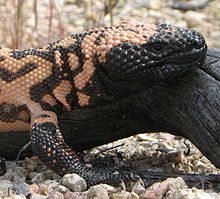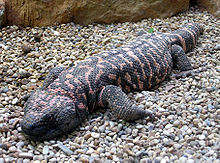- The Gila monster (Heloderma suspectum, /ˈhiːlə/ HEE-lə) is a species of venomous lizard native to the southwestern United States and northwestern Mexican state of Sonora.
A heavy, slow-moving lizard, up to 60 cm (2.0 ft) long, the Gila
monster is the only venomous lizard native to the United States and one
of only two known species of venomous lizards in North America, the
other being its close relative, the Mexican beaded lizard (H. horridum).[2]
Though the Gila monster is venomous, its sluggish nature means it
represents little threat to humans. However, it has earned a fearsome
reputation and is sometimes killed despite being protected by state law
in Arizona.[1][3]
Description, taxonomy and etymology
In this species, the largest extant lizard native to North America north of the Mexican border (non-natives like green iguanas are larger), snout-to-vent length is from 26 to 36 cm (10 to 14 in). The tail is about 20% of the body size and the largest specimens may reach 51 to 56 cm (20 to 22 in) in total length. Body mass is typically in the range of 350 to 700 g (0.77 to 1.54 lb), with 11 males having been found to average 468 g (1.032 lb). Reportedly, the very heaviest, largest specimens can weigh as much as 2,300 g (5.1 lb).[4][5][6]The Gila monster has one close living relative, the beaded lizard (H. horridum), as well as many extinct relatives in the Helodermatidae, the evolutionary history of which may be traced back to the Cretaceous period. The genus Heloderma has existed since the Miocene, when H. texana lived, and fragments of osteoderms from the Gila monster have been found in late Pleistocene (10,000–8,000 years ago) deposits near Las Vegas, Nevada. Because the helodermatids have remained relatively unchanged morphologically, they are occasionally regarded as living fossils.[7] Although the Gila monster appears closely related to the monitor lizards (varanids) of Africa, Asia and Australia, their wide geographical separation and the unique features not found in the varanids indicate the Gila monster is better placed in a separate family.[8]
Plate from the Century Cyclopedia depicts the Gila monster
Distribution and habitats
Head with bead-like scales and strong forelegs and claws suitable for digging
Ecology
Gila monsters spend 90% of their time underground in burrows or rocky shelters.[citation needed] They are active in the morning during the dry season (spring and early summer); later in the summer, they may be active on warm nights or after a thunderstorm. They maintain a surface body temperature of about 30 °C (86 °F).[13] Gila monsters are slow in sprinting ability, but they have relatively high endurance and maximal aerobic capacity (VO2 max) for a lizard.[14] They are preyed upon by coyotes and raptors.Diet
The Gila monster eats small birds, mammals, frogs, lizards, insects, and carrion.[15] The Gila monster feeds primarily on bird and reptile eggs, and eats infrequently (only five to ten times a year in the wild),[16] but when it does feed, it may eat up to one-third of its body mass.[4] It uses its extremely acute sense of smell to locate prey, especially eggs. Its sense of smell is so keen, it can locate and dig up chicken eggs buried 15 cm (6 in) deep and accurately follow a trail made by rolling an egg.[8]Prey may be crushed to death if large or eaten alive if small, swallowed head-first, and helped down by muscular contractions and neck flexing. Unusually, after food has been swallowed, the Gila monster immediately resumes tongue flicking and search behavior, probably as a result of a history of finding clumped prey such as eggs and young in nests.[13] Gila monsters are able to climb trees and cacti in search of eggs.[17]
Venom
| “ | I have never been called to attend a case of Gila monster bite, and I don't want to be. I think a man who is fool enough to get bitten by a Gila monster ought to die. The creature is so sluggish and slow of movement that the victim of its bite is compelled to help largely in order to get bitten. | ” |
| — Dr. Ward, Arizona Graphic, September 23, 1899 | ||
Pioneer beliefs
In the Old West, the pioneers believed a number of myths about the Gila monster, including that the lizard had foul or toxic breath and that its bite was fatal.[18] The Tombstone Epitaph of Tombstone, Arizona, wrote about a Gila monster that a local person caught on May 14, 1881:This is a monster, and no baby at that, it being probably the largest specimen ever captured in Arizona. It is 27 inches long and weighs 35 lb. It was caught by H. C. Hiatt on the road between Tombstone and Grand Central Mill and was purchased by Messrs. Ed Baker and Charles Eastman, who now have it on exhibition at Kelley's Wine House, next door above Grand Hotel, Allen Street. Eastern people who have never seen one of these monsters should not fail to inspect his Aztecship, for they might accidentally stumble upon one some fine day and get badly frightened, except they know what it is.On May 8, 1890, southeast of Tucson, Arizona Territory, Empire Ranch owner Walter Vail captured and thought he had killed a Gila monster. He tied it to his saddle and it bit the middle finger of his right hand and wouldn't let go. A ranch hand pried open the lizard's mouth with a pocketknife, cut open his finger to stimulate bleeding, and then tied saddle strings around his finger and wrist. They summoned Dr. John C. Handy of Tucson, who took Vail back to Tucson for treatment, but Vail experienced swollen and bleeding glands in his throat for sometime afterward.[18]
— [18]
Dr. Handy's friend, Dr. George Goodfellow of Tombstone, was among the first to research the actual effects of Gila monster venom. Scientific American reported in 1890 that "The breath is very fetid, and its odor can be detected at some little distance from the lizard. It is supposed that this is one way in which the monster catches the insects and small animals which form a part of its food supply—the foul gas overcoming them." Goodfellow offered to pay local residents $5.00 for Gila monster specimens. He bought several and collected more on his own. In 1891 he purposefully provoked one of his captive lizards into biting him on his finger. The bite made him ill and he spent the next five days in bed, but he completely recovered. When Scientific American ran another ill-founded report on the lizard's ability to kill people, he wrote in reply and described his own studies and personal experience. He wrote that he knew several people who had been bitten by Gila monsters but had not died from the bite.[18]
Goodfellow published articles about rattlesnake and Gila monster bites in Scientific American and Southern California Practitioner.[19]
Delivery
The Gila monster produces venom in modified salivary glands in its lower jaw, unlike snakes, whose venom is produced in the upper jaw.[15] The Gila monster lacks the musculature to forcibly inject the venom; instead, the venom is propelled from the gland to the tooth by chewing. Capillary action brings the venom out of the tooth and into the victim.[7] The teeth are loosely anchored, which allows them to be broken off and replaced throughout life. Gila monsters have been observed to flip over while biting the victim, presumably to aid the flow of the venom into the wound. Because the Gila monster's prey consists mainly of eggs, small animals, and otherwise "helpless" prey, the Gila monster's venom is thought to have evolved for defensive rather than for hunting use. A defensive use would explain the Gila monster's bright warning coloration.[8]Toxicity
A reticulated Gila monster (H. s. suspectum)
More than a dozen peptides and other substances have been isolated from the Gila monster's venom, including hyaluronidase, serotonin, phospholipase A2, and several kallikrein-like glycoproteins responsible for the pain and edema caused by a bite. Four potentially lethal toxins have been isolated from the Gila monster's venom, including horridum venom, which causes hemorrhage in internal organs and exophthalmos (bulging of the eyes),[20] and helothermine, which causes lethargy, partial paralysis of the limbs, and hypothermia in rats. Most are similar in form to vasoactive intestinal peptide (VIP), which relaxes smooth muscle and regulates water and electrolyte secretion between the small and large intestines. These bioactive peptides are able to bind to VIP receptors in many different human tissues. One of these, helodermin, has been shown to inhibit the growth of lung cancer.[7][21][22]
The constituents of the lizard's venom that have received the most attention from researchers are the bioactive peptides, including helodermin, helospectin, exendin-3, and exendin-4.[23] Exendin-4 has formed the basis of a class of medications for the treatment of type 2 diabetes, known as Glucagon-like peptide-1 agonists. Exenatide was the first product in the class to reach the market and was launched in 2005.
Drug research
| Wikinews has related news: New drug from lizard's saliva |
Life history
Gila monster at the Bristol Zoo
Little is known about the social behavior of H. suspectum, but they have been observed engaging in male-male combat, in which the dominant male lies on top of the subordinate one and pins it with its front and hind limbs. Both lizards arch their bodies, pushing against each other and twisting around in an effort to gain the dominant position. A wrestling match ends when the pressure exerted forces them to separate, although bouts may be repeated one after the other. These bouts are typically observed just before the mating season. Those with greater strength and endurance are thought to win more often and enjoy greater reproductive success.[27] Although the Gila monster has a low metabolism and one of the lowest lizard sprint speeds, it has one of the highest aerobic scope values (the increase in oxygen consumption from rest to maximum metabolic exertion) among lizards, allowing them to engage in intense aerobic activity for a sustained period of time. Males have been observed to have higher aerobic scopes than females, presumably because of sexual selection for a trait advantageous in prolonged combat.[14] The Gila monster may live up to 20 years in the wild, or 30 in captivity.[28]











No comments:
Post a Comment
Note: Only a member of this blog may post a comment.